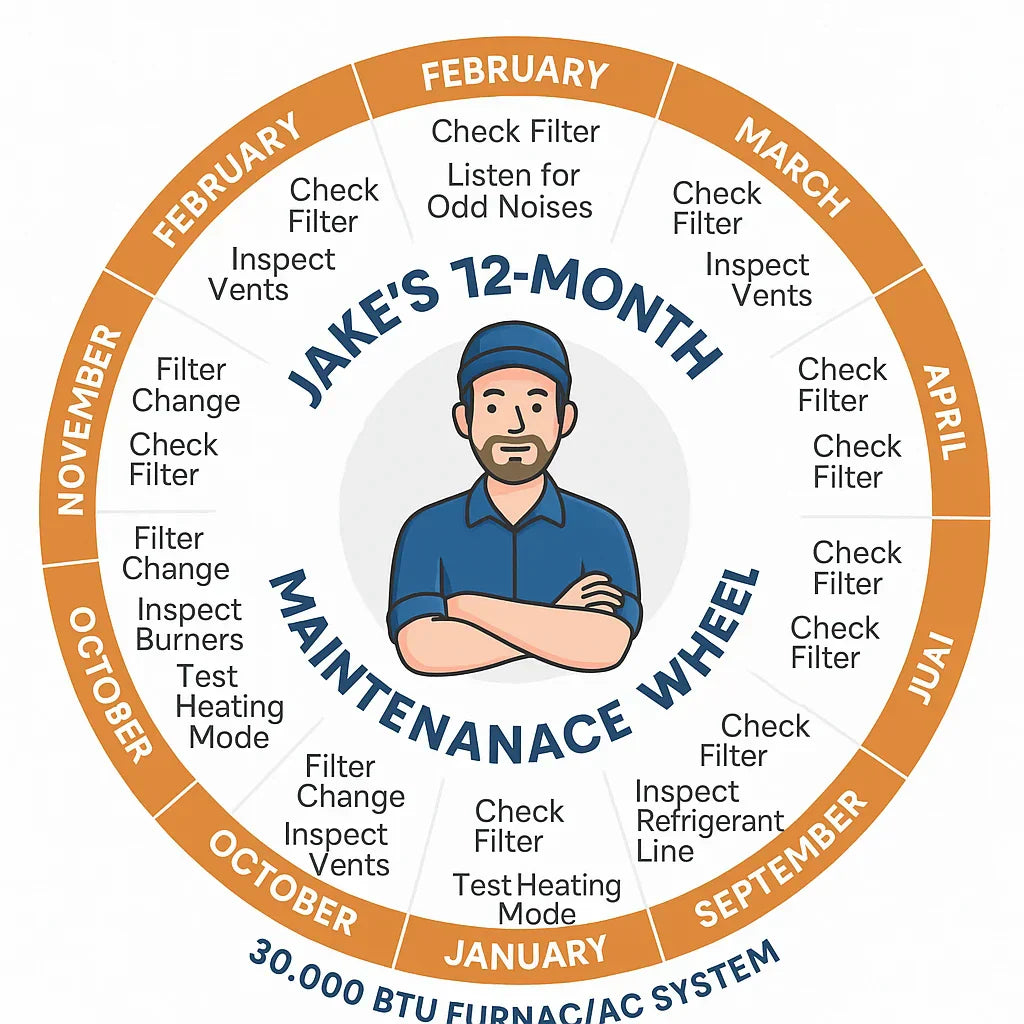I’m Jake, and I’ll tell you something I’ve learned in years of working with HVAC systems: the units that last the longest and perform the best aren’t necessarily the most expensive—they’re the ones that are maintained consistently.
I’ve got a neighbor whose 30,000 BTU furnace/AC combo is over 10 years old and still running like a champ. Why? Because he follows a maintenance plan that keeps everything clean, tuned, and ready for the season ahead.
Neglecting maintenance can lead to:
-
Higher energy bills
-
Frequent breakdowns
-
Shortened system lifespan
-
Reduced comfort in your home
The good news? You can handle a lot of maintenance yourself, and the rest just requires scheduling a pro at the right time.
🌀 Section 1 – Understanding Your 30k BTU Combo System
A 30,000 BTU combo system means:
-
Cooling capacity: about 2.5 tons of heat removal per hour.
-
Heating capacity: matched to your furnace type (gas or electric).
Main components that need attention:
-
Furnace – Heats your home during cold months.
-
Outdoor condenser unit – Removes heat from your home in summer.
-
Evaporator coil – Transfers heat inside your duct system.
-
Blower motor – Moves air through your ducts.
-
Ductwork – Delivers conditioned air throughout your home.
-
Thermostat – The control hub.
When any of these are dirty, misaligned, or worn, performance suffers.
📅 Section 2 – Monthly Maintenance Tasks (DIY)
1. Check & Replace Air Filters
-
Why: Dirty filters restrict airflow, making your blower work harder and reducing efficiency.
-
How often: Check monthly, replace every 1–3 months.
-
Tip: Use the filter size recommended by the manufacturer—don’t “upsize” thinking it’ll trap more; it can restrict airflow too much.
2. Inspect Vents & Returns
-
Look for dust buildup or blockages (furniture, curtains).
-
Make sure return grilles aren’t obstructed.
3. Listen for Noises
-
Rattles, squeaks, or grinding can be early warning signs.
🌱 Section 3 – Seasonal Maintenance Tasks
Spring (Before Cooling Season)
-
Clean Outdoor Condenser Coils: Use a garden hose with gentle spray to wash dirt, pollen, and debris off the fins.
-
Inspect Refrigerant Lines: Check the insulation; replace any that’s cracked or missing.
-
Test Cooling Mode: Run the system for 15 minutes, ensure cool air is coming from vents.
Fall (Before Heating Season)
-
Inspect Furnace Burners: Look for dust or rust; clean gently if accessible.
-
Check Ignition & Flame Sensor: If the flame is flickering yellow instead of steady blue, call a pro—it could indicate combustion issues.
-
Test Heating Mode: Run the furnace for 15 minutes, confirm warm air and proper cycling.
🛠 Section 4 – Annual Professional Maintenance
Even if you handle your monthly and seasonal tasks, schedule one professional tune-up a year for both the heating and cooling sides.
A pro will:
-
Inspect and clean the evaporator and condenser coils.
-
Test and tighten electrical connections.
-
Measure refrigerant charge and adjust if needed.
-
Lubricate moving parts (if applicable).
-
Test gas pressure and combustion safety (for gas furnaces).
-
Check blower motor amperage draw.
-
Verify thermostat calibration.
Cost: $100–$200 per visit, often less with annual maintenance contracts.
⚡ Section 5 – Extra Care Tips for Peak Efficiency
-
Keep Outdoor Unit Clear: Maintain at least 2 feet of clearance on all sides for airflow.
-
Mind the Landscaping: Don’t let bushes or weeds grow into the unit.
-
Seal & Insulate Ducts: Especially if they run through unconditioned spaces; this can improve system efficiency by up to 20% according to ENERGY STAR.
-
Check Thermostat Batteries: Replace once a year for reliable control.
🚫 Section 6 – Common Mistakes to Avoid
-
Skipping Filter Changes – This is the fastest way to kill airflow and overwork your blower.
-
DIY Refrigerant Topping – Without proper tools, you can damage the system or cause a refrigerant leak.
-
Closing Too Many Supply Vents – Can create high static pressure, stressing the blower.
-
Neglecting the Outdoor Unit – Dirt buildup on coils drastically reduces cooling efficiency.
📆 Section 7 – Jake’s Maintenance Calendar
| Month | DIY Tasks | Pro Tasks |
|---|---|---|
| January | Check filter | – |
| February | Check filter, listen for odd noises | – |
| March | Check filter, inspect vents | – |
| April | Filter change, clean condenser coils, test cooling mode | – |
| May | Check filter | – |
| June | Check filter, clear debris from outdoor unit | – |
| July | Check filter | – |
| August | Check filter, inspect refrigerant line insulation | – |
| September | Check filter, inspect vents | – |
| October | Filter change, inspect burners, test heating mode | – |
| November | Check filter | Pro heating tune-up |
| December | Check filter | – |
📞 Section 8 – When to Call a Pro Immediately
Call right away if you notice:
-
Burning smell when running the furnace.
-
Gas odor (shut system down and call the gas company first).
-
Musty smell from AC (possible mold in ducts or coil).
-
Unusual noises – grinding, banging, screeching.
-
Sudden spike in energy bills without obvious cause.
✅ Conclusion
A 30,000 BTU furnace/AC combo is a solid choice for many homes, but just like a car, it needs routine care to deliver its best performance year after year.
Stick to:
-
Monthly filter checks
-
Seasonal coil cleaning and mode testing
-
Annual pro inspections
…and you’ll enjoy better comfort, lower bills, and a system that can outlive its warranty.
In the next article we will know more about: Cold Climate Ready? How a 30,000 BTU System Performs in Winter







